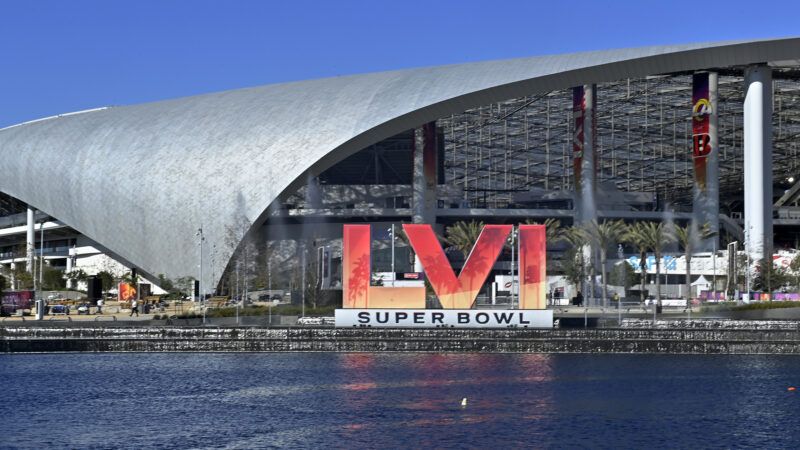The Super Bowl Will Be Played in the Most Expensive Stadium Ever Built. Taxpayers Didn't Pay a Dime.
Meanwhile, Virginia and Washington, D.C., are in a bidding war to decide which taxpayers will have the chance to pay for the Washington Commanders' new stadium. It shouldn't be this way.

SoFi Stadium, Southern California's glittering new sports cathedral with its sweeping glass-and-steel lattice roof, is about to become one of America's most well-known athletic venues.
On Sunday night, SoFi Stadium will host its first (but certainly not its last) Super Bowl, when the hometown Los Angeles Rams square off against the surprising Cincinnati Bengals for the National Football League's championship. College football's national championship game will be played there next year. The opening and closing ceremonies of the 2028 Olympics are scheduled to take place there, along with the event's track and field and archery competitions. And it's highly likely that SoFi will host some of the most important games during the 2026 World Cup.
But the most remarkable thing about the stadium, which opened in September 2020, isn't its very-SoCal design elements or the packed schedule of high-profile events to be held there.
It's that the billion-dollar stadium was built without public subsidies. In terms of public policy, SoFi Stadium might be one of the most important stadiums in American history—a venue that points toward a future where billionaires who love sports, rather than taxpayers, serve as patrons of professional athletics rather than rent-seekers.
The man behind SoFi Stadium is Rams' owner Stan Kroenke, who brought the team back to L.A. after it had spent 21 seasons in St. Louis, Missouri. While there, the Rams played in the soulless Edward Jones Dome, which was originally built with $280 million in public funds—some of which the city is still paying off, despite no longer having a team.
The Rams new stadium in Inglewood—which they share with the Los Angeles Chargers, who pay rent to Kroenke to use the facility—is part of a complex that includes a concert hall, shopping center, office buildings, condos, a luxury hotel, and a 25-acre park. The entire footprint of the site is three times larger than Disneyland, with estimated total construction costs reportedly near $5 billion—making it the most expensive stadium ever built.
There's some cronyism at play, of course. The city of Inglewood is allowing Kroenke to pocket some of the sales taxes from purchases made in the stadium complex, a kickback that's worth an estimated $180 million, to pay for infrastructure and an internal bus transit system. You could also argue, as Stanford University economist and frequent stadium critic Roger Noll has, that other possible uses for the nearly 300-acre site might have been more productive. But one of the great things about the stadium being privately funded is that those opportunity costs are borne by Kroenke, his fellow investors, and the NFL—not by taxpayers. Overall, SoFi Stadium is "a really good deal" when compared to any other stadium built in America during the past three decades, Noll told The Washington Post in 2019.
New development always comes with tradeoffs, of course, and SoFi Stadium is no exception. Both the Los Angeles Times and Sports Illustrated published features this week about the impact the new stadium has had on the surrounding neighborhood. Property values are soaring in the area, which is great for homeowners but not so good for renters who are getting priced out. Other people make the standard complaints about game-day traffic and other changes that come with suddenly living in a more desirable place.
The SI piece, in particular, is a bit bizarre in how it frames itself as an investigation of "the true cost" of the stadium. Sure, there might be some negative tradeoffs—though it is not at all clear that the stadium is responsible for the sharply rising property values, as Field of Schemes blogger Neil deMause explains here—but the "true cost" of SoFi Stadium is significantly less than any stadium built with hundreds of millions of taxpayer subsidies.
Maybe I'm just being extra sensitive to that sort of thing right now because I'm a resident of Virginia, and my state lawmakers are reportedly readying a $1 billion package meant to lure the Washington Redskins Football Team Commanders from the Maryland suburbs of D.C. to the Virginia suburbs. It is "maybe the biggest NFL stadium subsidy proposal in history," according to deMause, who has made a career out of tracking these crony deals, though he notes that the details remain unclear for now.
If that deal comes to fruition, those costs will be borne by all residents of Virginia—including those who live hours away from Washington and those who have no interest in attending a Commies game. They won't see their property values increase or be able to take advantage of increased economic activity like the residents of Inglewood. They will only get costs, no benefits.
The city of Washington, D.C., is reportedly also preparing an offer that would presumably put the district's residents on the hook for a new football stadium too. This is a bidding war that taxpayers in the whole D.C. area should be hoping to lose.
Commanders' owner Dan Snyder is a multibillionaire, like Kroenke. If he wants a new stadium for his vanity project football team, he should put up the money for it. In the meantime, city and state officials across the country should point to SoFi Stadium as evidence that there's no need for taxpayers to subsidize these projects.